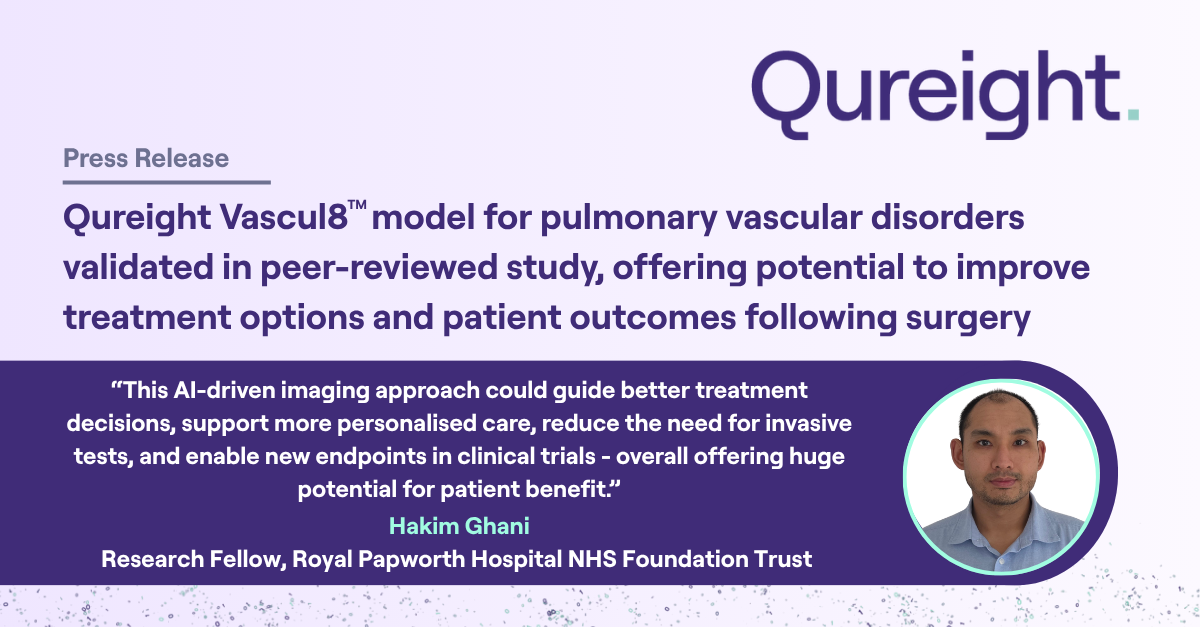
Cambridge, UK, 27 October 2025 – Qureight, a techbio company advancing the understanding of lung and heart disease through application of its AI-powered imaging and clinical data curation platform, today announced the publication of a peer-reviewed study validating its Vascul8™ model for pulmonary vascular disorders, in the American Journal of Respiratory Cell and Molecular Biology1. The study demonstrated that the Vascul8 model provides accurate, automated insights into response to surgery for patients treated for chronic thromboembolic pulmonary hypertension (CTEPH). These insights enabled the identification of patients at high-risk of residual pulmonary hypertension, reducing the need for routine post-operative right heart catheterisation.
CTEPH is caused by the presence of chronic blood clots (chronic pulmonary thromboembolisms) in the arteries of the lung that do not fully break down. Pulmonary endarterectomy (PEA) surgery is often carried out to remove the clots; however, patients can be left with residual pulmonary hypertension (PH) and require further intervention or treatment. The current approach to stratify patients at risk of pulmonary hypertension involves right heart catheterisation (RHC), an invasive and resource intensive procedure, to measure pressure and blood flow in pulmonary circulation. The findings reported in this paper show we can effectively screen patients for residual PH, and therefore perform right heart catheterisation only on those with high risk for residual PH, reducing the number of invasive, costly procedures.
Qureight’s AI-powered imaging and clinical data curation platform and deep learning models identify key structural changes in the lung to assess disease progression. In this study, Qureight’s Vascul8 model was used to analyse Computed Tomography Pulmonary Angiograms (CTPAs) to quantify changes in blood vessel volume in patients with CTEPH following PEA surgery. Analysis with Vascul8 enabled precise vascular segmentation, including differentiating between arterial and venous blood volume, providing an objective, automated approach to identifying changes in vessel volume and predicting which patients are most at risk of residual pulmonary hypertension. This study demonstrates how Qureight’s deep learning technology offers a more personalised, accurate and non-invasive approach to CTEPH treatment management, providing physicians with deeper insights into a patient’s severity of disease and need for further intervention.
Joanna Pepke-Zaba, Consultant Physician, Royal Papworth Hospital NHS Foundation Trust, Associate Professor, University of Cambridge, and lead author of the paper, added: “CTEPH has for a long time had a complex disease management pathway, requiring the subjective expertise of multidisciplinary teams. We are excited to have worked on this study, where we show an alternative approach to imaging CTEPH and patient management, employing Qureight’s imaging analysis model, Vascul8. This signals a major step forward in deploying imaging in severe and complex respiratory and vascular diseases.”
Hakim Ghani, Research Fellow, Royal Papworth Hospital NHS Foundation Trust and first author of the paper, said: “Powered by Vascul8, automated quantification of lung blood volumes from CT scans can help identify patients with chronic blood clots who remain at risk of residual pulmonary hypertension after surgery. This AI-driven imaging approach could guide better treatment decisions, support more personalised care, reduce the need for invasive tests, and enable new endpoints in clinical trials - overall offering huge potential for patient benefit.”
Simon Walsh, CSO, Qureight, and co-author of the paper, commented: “This study shows the promise of our deep-learning vascular biomarkers and demonstrates that our imaging platform can be used beyond fibrotic lung disease, in pulmonary vascular disorders such as CTEPH. This breakthrough establishes the foundation for future biopharma partnerships in pulmonary vascular disease, reinforcing our leadership position in regulatory-grade, disease-agnostic imaging biomarkers built for clinical and translational research, to accelerate drug development, enable smarter patient selection, and support precision medicine.”
1. Ghani, H. et al. (2025) “Pulmonary Blood Volumes on CT Predict Residual Pulmonary Hypertension Post-Pulmonary Endarterectomy,” American Journal of Respiratory Cell and Molecular Biology, doi:10.1165/rcmb.2025-0121OC
